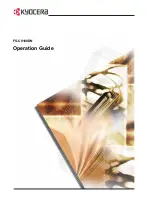
169
Security – Authentication
Overview
Users Controlled by Authentication
Authenticated Users
These are users who are registered with the machine. When using a restricted service, authenticated
users are prompted to type their user IDs on the authentication screen.
Guest Users
These are users who are permitted to use the machine using the Guest password set by the System
Administrator.
Authentication Configuration and related Types
No Login Required
– Users can access any service without restriction. This is the default type for the
machine.
Login to Local Accounts
– This type uses the user information registered on the machine to manage
authentication.
Login to Remote Accounts, matched with Network Accounting as Accounting Type
– Network
Access (authentication) uses the user information managed on a remote accounting service to
manage authentication.
User information, managed on the remote accounting service, is sent to be registered on the machine.
When the user information on the remote accounting service is updated, the updated information must
be sent from the remote accounting service to the machine.
Network Access allows a unified management of user information for multiple devices.
Login to Remote Accounts, with Accounting Type set to Off or Disabled –
Remote authentication
uses a remote authentication server to manage user access to the machine. User information is not
required to be registered locally on the machine. Note that with remote authentication you cannot
have as much individual service restriction as you have with Local machine authentication. To
increase control over individual service access, with a system such as Kerberos, for example, you
need to use an Authentication Agent (which, as of February 2007 was still available from the
Authentication System hot link of the Remote Authentication / Directory Service folder of Internet
Services).
Note: When registering user information on a remote authentication server, use up to 32 characters for
a user ID and up to 128 characters for a password. Note, however, for SMB the password limit is 32
characters.
Login Type set to Xerox Secure Access with Accounting Disabled
– When the Login Type is set to
Xerox Secure Access, you will also need to configure a networked Authentication Server to supply
credentialing information to the Secure Access Server. The Authentication Server can be running
Kerberos, SMB, or LDAP and is configured as stated in the Configuring Remote Authentication topics
of this guide section. Note that the Accounting Type can also be set to Network Accounting, to work
with a networked accounting package, as stated in the Configuring Xerox Secure Access topic, in this
section of this guide.
Refer to the Equitrac™ documentation for further setup instructions.
Summary of Contents for WorkCentre 7335
Page 1: ...System Administrator s Guide 701P47693 WorkCentre 7328 7335 7345...
Page 12: ...x...
Page 300: ...701P47693...
















































